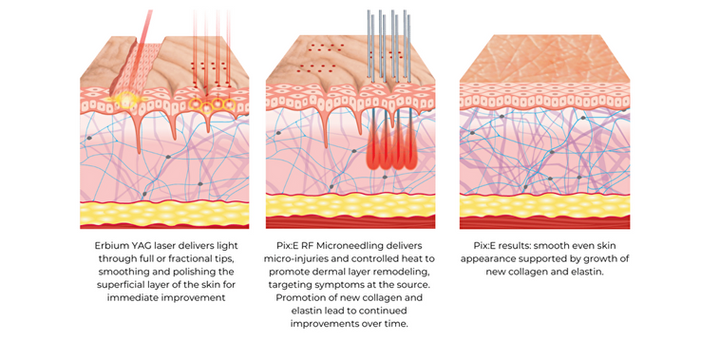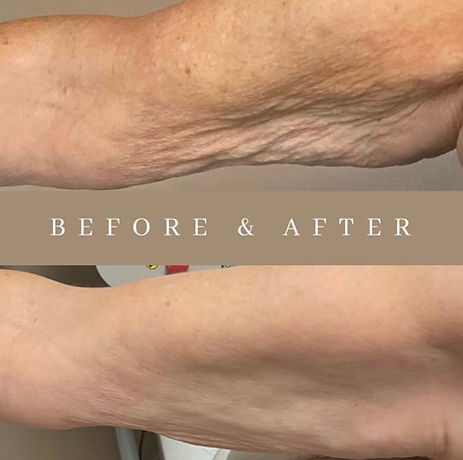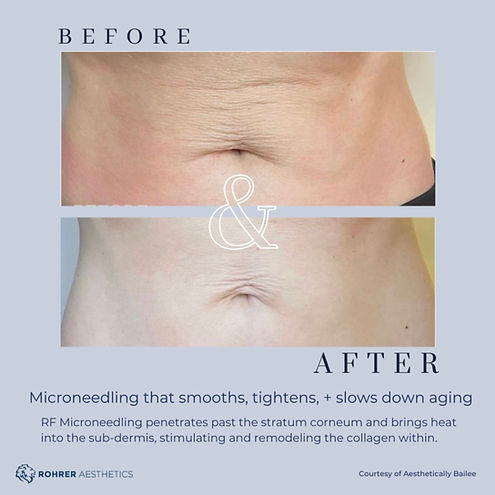
Pixie: Radiofreqency Microneedling & Erbium Laser
Pixie is the first and only FDA-cleared device combining 4 MHz RF Microneedling and Erbium YAG technologies into one device and treatment. It is a combination treatment that helps tighten and brighten the skin. This innovative combination offers a dual-action solution for skin rejuvenation:
RF microneedling penetrates the skin to deliver energy deep into the dermis, promoting the production of collagen and elastin, which enhances skin texture, firmness, and tone.
Erbium laser skin resurfacing gently removes the outer layer of skin, initiating cellular renewal to diminish the appearance of fine lines, wrinkles, acne scars, and sun damage.
Pix:E is designed to be fully customizable, allowing for adjustments in needle depth and laser settings, ensuring each treatment is tailored specifically to meet individual skin types and aesthetic goals.


Radio Frequency (RF) micro needling
Radio Frequency (RF) micro needling is a non-surgical technique that utilizes radio frequency energy and tiny needles to rejuvenate the skin. The PiXie-RF system from Rohrer Aesthetics is the first and only FDA cleared device combines the latest advancements in micro needling and RF technologies to deliver highly-effective treatments without the downsides and expense of surgery. RF microneedling can act as a non-surgical facelift alternative to help correct visible signs of aging. During treatment, bipolar energy is applied on the target area, putting heat into the deep layers of the epidermis. The processes of hemostasis and coagulation help activate the production of collagen and a regeneration of vital elastin cells. We can adjust the depth of the microneedles depending on the specific treatment area. This can be particularly important especially when addressing certain parts such as below the eyes, on the forehead, and cheeks. RF microneedling using the PiXie-RF system results in positive changes in complexion along with skin that is much softer, firmer, and more resilient.
Am I a Candidate for RF Microneedling Using the Pixie-RF System?
Most people are good candidates for RF microneedling with the Pixie-RF system. This treatment is safe for all skin types and minimizes the risks of hyperpigmentation and other side effects in individuals who have a darker skin tone. Typical patients are those who desire skin tightening and rejuvenation in order to enhance their radiance and complexion.
What Problem Areas Does the PiXie-RF System Address?
Our non-invasive dermatological treatments with the PiXie-RF system address a wide variety of aesthetic concerns:
-
Skin Tightening
-
Wrinkle Reduction
-
Scar Improvement (Acne Scars, Traumatic Scars, Chicken Pox Scars, etc.)
-
Skin Tone & Texture Improvement
-
Stretch Mark Reduction
-
Pore Reduction
-
Rejuvenation and Increased Collagen Production
-
Eliminates Hyperhidrosis (excess sweating in the under arms, palms of hands, soles of feet)
-
Scar Reduction
-
Double Chin Reduction
-
Jowl Lifting
-
Eyebrow Lifting
-
Neck Lifting




This innovative treatment option is also suitable for patients who are looking to get rid of dramatic skin drooping. Our patients no longer have to worry about sagging eyebrows, massive pores, scruffy hands, past acne breakouts, or scars with Pixie – RF treatment.
What is Erbium Laser Resurfacing?

Erbium laser resurfacing is a procedure that uses advanced laser technology to remove the outer layers of skin, revealing new, refreshed skin cells below. This can be used to help smooth the texture of the skin and create an even skin tone. In addition to removing the outer layers of skin, erbium laser resurfacing also stimulates the production of collagen and elastin, which give skin youthful fullness. This procedure is similar to procedures like chemical peels or dermabrasion used to reduce the appearance of fine lines, wrinkles, hypo or hyperpigmentation, and scarring. Erbium lasers allow for a range of treatment depths to address a wide variety of cosmetic concerns. A combination or sequence of laser treatments may be used to deliver the desired results over the course of several visits.
While there are many lasers available to improve the appearance of the skin, erbium lasers are often relied upon for their precision. Because of the greater amount of depth control built into most erbium laser treatment systems, smaller areas can be targeted, and these lasers can be used safely on sensitive areas like the face, neck, hands, or chest. Because of the treatment precision, the provider is able to minimize post treatment discomfort and recovery time compared with CO2 laser treatments and other laser resurfacing options.
What is the difference between Erbium and CO2 Laser?
Erbium lasers necessitate a shorter recovery period due to the shallower wounds they create. Additionally, Erbium lasers cause less thermal damage to the surrounding skin tissue, facilitating quicker healing. In contrast, CO2 lasers often produce deeper injuries and more extensive thermal damage, leading to longer recovery times. This makes Erbium lasers a preferable option for patients seeking faster healing with minimal thermal impact on the skin.
Although Erbium:YAG lasers do not penetrate as deeply as CO2 lasers, they’re able to mimic the effects of CO2 lasers by multiple passes, stacking and increasing the pulse duration while limiting the risk of unwanted side effects. The flexibility of an Erbium:YAG laser’s pulse formats and energy capabilities make it a desirable and safer alternative to the older CO2 laser for ablative and fractional treatments.
Who is a Good Candidate for Erbium Laser Resurfacing?
Like other laser treatments, erbium laser technology works best on lighter skin tones, but the advanced precision of the erbium laser means that a darker skin tone does not necessarily mean patients won’t be candidates for erbium laser resurfacing. However, they should take time to discuss potential side effects with their provider before selecting this procedure to ensure it’s their best option.

How Does Erbium Laser Resurfacing Treatment Work?
Because erbium lasers penetrate into deeper layers of skin, the sensation can be uncomfortable. For this reason, Dr Ignacio will apply a topical or local anesthetic to numb the area before treatment. Dr Ignacio will then apply the erbium laser to the specific area and depth of skin to address your specific concerns. Erbium lasers interact with water in the body to intentionally damage the skin cells. This jump-starts the body’s healing processes, increases the production of collagen and elastin, and generally triggers the production of healthy, new skin cells. After treatment, you may be given bandages or dressings that need to be applied to ensure proper healing and reduce the risk for side effects. Make sure to follow all aftercare instructions to achieve the best results.
Are There Side Effects to Erbium Laser Resurfacing Treatment?
The most common side effects are mild swelling and some discomfort in the first few days after your erbium laser resurfacing treatment. Some patients also experience redness that can last throughout the healing process. Healing may take several days, depending on how aggressive the laser resurfacing is. As the skin begins to heal, you may see some flaking or peeling like what you would see after a bad sunburn. Take care to avoid pulling or scratching at any peeling areas as you may unintentionally damage your skin, which leaves you at risk for scarring and infection. Instead, allow the skin to be shed naturally. Follow the skin care instructions given to you by your provider for the best healing process.
What You Need to Do Before Your The Pix:E Treatment:
-
Avoid the sun for 2 weeks prior to your procedure.
-
Avoid sunless tanning lotions on the treatment area for 2 weeks prior to the procedure.
-
Avoid injectables such as Botox, Filler or Sculptra for 2 weeks prior to procedure.
-
Avoid treatments such as chemical peels, microneedling or other ablative procedures for 4 weeks prior to the procedure.
-
Let your provider know if you have a history of cold-sores as an anti-viral prophylactic is recommended for patients with a history of herpes simplex.
-
If you have darker skin tones, discuss the risks of hyper and hypopigmentation with your provider. It may be recommended for you to use a topical tyrosinase inhibitor such as Hydroquinon 4% for 4 weeks prior to ablative treatment (minimum of 2 weeks is necessary to avoid pigmentary changes)
-
Discontinue active products such as retinol or hydroquinone three days prior to treatment.
-
Discontinue anti-inflammatories/fish oil 3 days prior to treatment.
What to Expect During The Pixie Treatment?
-
Consultation: Your provider will go over your medical history, expectations and post-care in detail prior to the procedure and you will be asked to sign a consent form. Photos may be taken for documentation purposes.
-
Comfort: We will numb you prior to your procedure but you could experience some stinging or burning sensation, or a moderate amount of discomfort.
-
Time: The procedure itself takes 45-60 minutes.
-
Eyewear: You will wear protective eyewear during the erbium laser portion of the treatment.
-
Post Treatment: After the procedure we may apply topicals specifically designed to go on the skin following a Pix:E Treatment. We may also apply a recovery mask or sterile water-soaked gauze for approximately 10 minutes to help the skin cool.
-
Protection: Prior to leaving your appointment, once the heat has dissipated, your provide will apply a semi-occlusive ointment
How is Recovery After RF Microneedling?
Following your RF microneedling, you may experience redness and mild swelling in the treatment area. This should, however, clear up in 24 hours. Patients who receive more intense treatments may experience these side effects for longer. You may be allowed to apply makeup as soon as a day. Recovering from RF microneedling is usually painless, quick, and easy. You should be able to carry on with your schedule and normal routines without much interruption. Many patients who undergo RF microneedling treatments have improved self-esteem and tend to feel more comfortable in their own skin.
Pix:E Treatment Aftercare:
-
First 24 hours post treatment: A certain degree of discomfort, redness, and/or irritation during and after treatment is expected. You may feel like you have a sunburn or wind burn. If any discomfort or irritation persists more than 24-hours, please notify your treating provider.
-
Cooling: You may apply a cool compresses may be used if necessary.
-
Swelling is normal; sleep with your head elevated for 2 days post-treatment.
-
Avoid Irritation: Care should be taken to prevent trauma to the treated site: avoid hot baths, massage, irritating skin care products or exfoliants, etc. The skin should be kept clean to avoid contamination or infection; any mechanical or thermal damage to the area must be avoided.
-
Sleep: Sleep on your back on a clean pillowcase.
-
Twice a day: Cleanse skin with a mild, gentle cleanser such as Cetaphil. Gently pat dry with a clean, soft cloth.
-
Protection: Reapply semi-occlusive ointment or other moisturizers provided by your treatment provider. Always keep skin moist until re-epithelialization has taken place. This generally occurs between day 3 and 5. At that time, begin applying a gentle moisturizer 2-3 times a day to prevent skin from becoming dry.
-
Skincare: Do not resume your normal skincare routine until you are completely healed - up to 5-10 days. After 2-3 days, you may use non-acidic cleansers, moisturizers and growth factor serums but avoid any retinols, vitamin C serums or acidic products. After 4 days you may start wearing a mineral based sunscreen (Zinc/Titanium Dioxide based)
-
Do not scratch or pick at the healing skin.
-
Drink at least 64 ounces of water per day.
-
Continue to avoid direct sun exposure for the next 4 weeks, for best results up to 6 months. Skin will be more sensitive to the sun.
-
Wear a 4-inch brimmed hat and sunglasses whenever possible. • You may resume makeup once skin has completely healed, typically between 5-7 days.
-
It is important to use any prescribed skincare products or medications as directed by your treatment provider.
-
Dark skin is more prone to hyperpigmentation. Notify your provider as soon as possible if you notice any areas on your skin are beginning to darken.
-
Contact your provider if there is any indication of blistering or infection.
